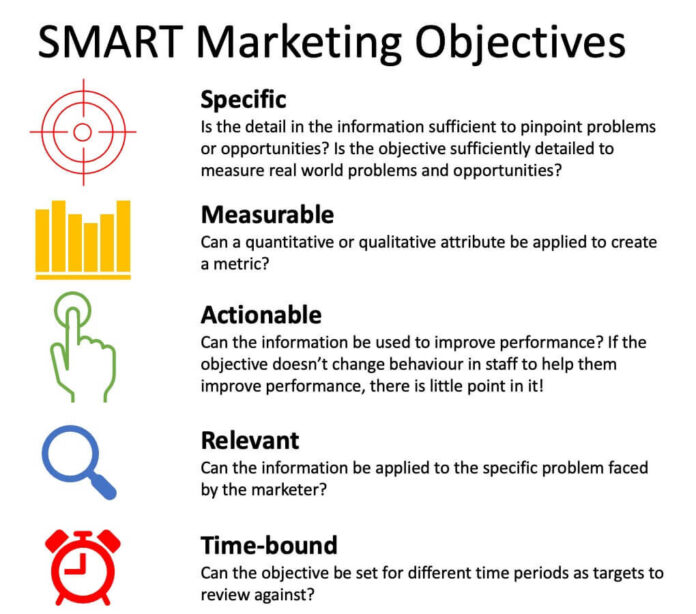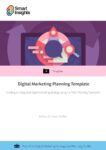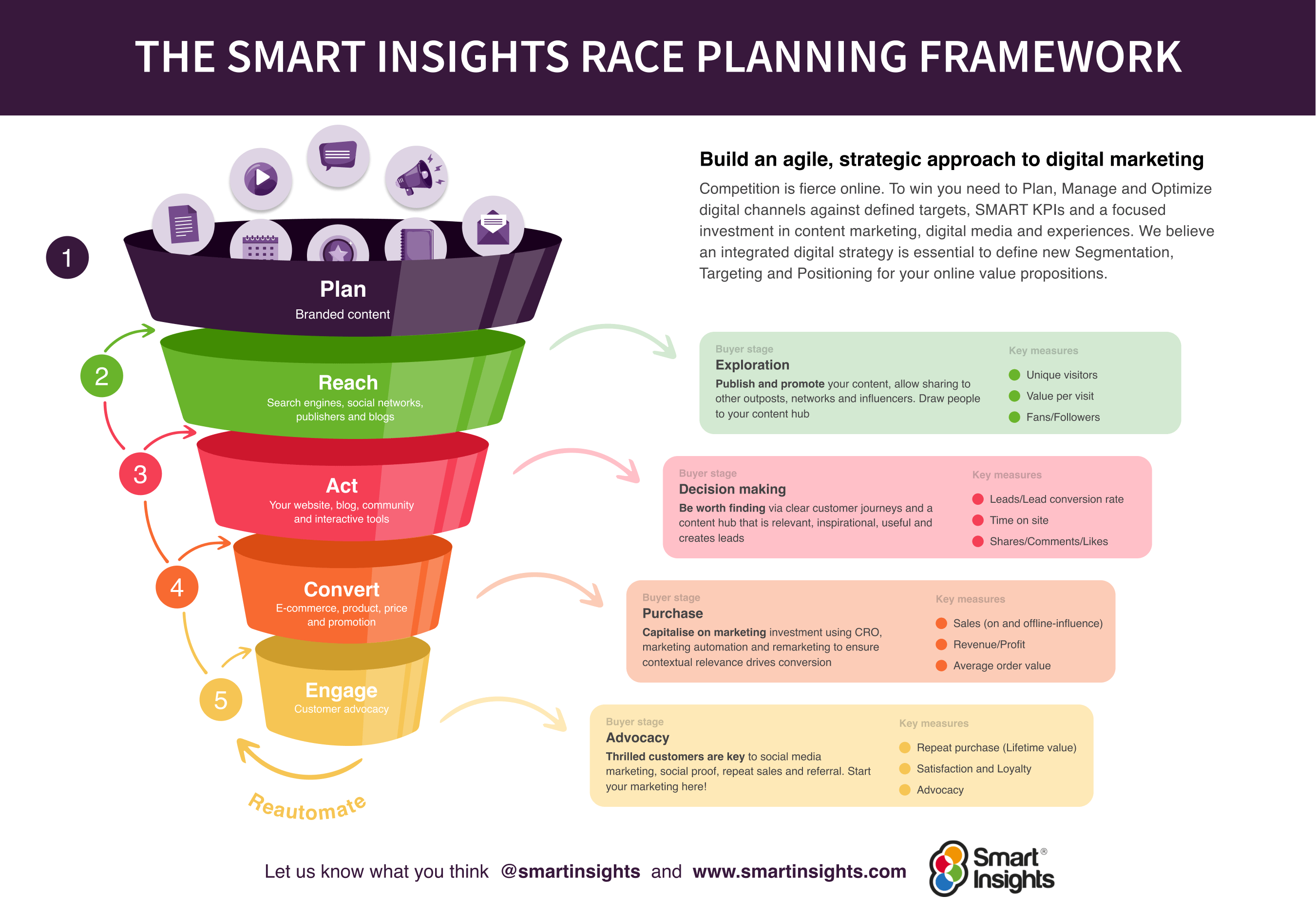From SMART to SMARTER marketing objectives: Discover how to define marketing objectives, measure your digital marketing goals, and use data to inform your marketing strategy
When identifying specific marketing objectives to support your long-term goals, it is common practice to apply the widely used SMART mnemonic. You will know that SMART is used to assess the suitability of objectives set to drive different strategies or the improvement of the full range of business processes.
By its simplest definition, an effective SMART marketing objective is:
Specific, measurable, actionable, relevant, and time-bound.
But you will learn in this article that beyond this well-known acronym, there are different variations and nuances which you can apply to practice Smarter Marketing.
What is Smarter Marketing?
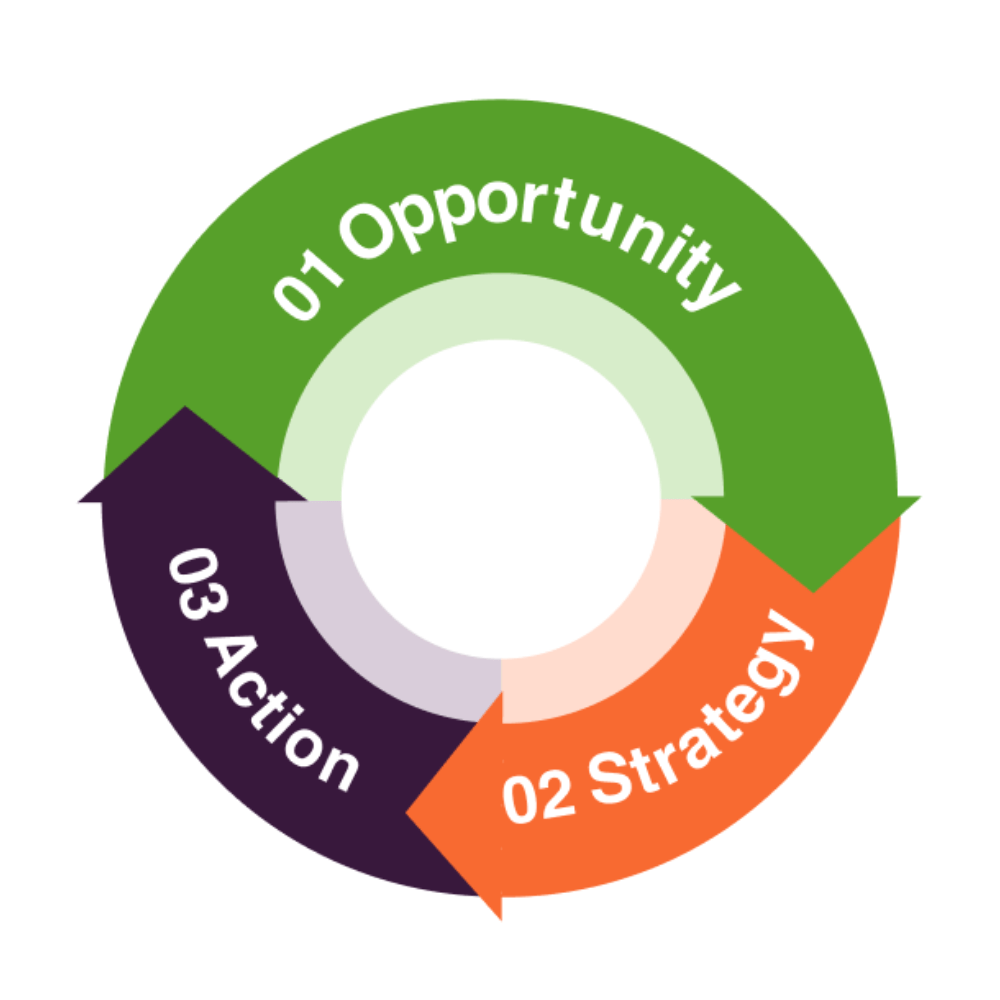 The SMART acronym is much more than a mnemonic since it defines a way of thinking about getting better results within business and marketing. This mindset is based on using data-driven marketing to better compete against other businesses in a sector from the approach we call OSA in our RACE Growth System for improving results from marketing.
The SMART acronym is much more than a mnemonic since it defines a way of thinking about getting better results within business and marketing. This mindset is based on using data-driven marketing to better compete against other businesses in a sector from the approach we call OSA in our RACE Growth System for improving results from marketing.
SMART objectives shouldn’t exist in isolation, instead they should support data-driven marketing since you should use them at all stage of planning and implementing marketing plans are part of this improvement process:
See our resource library for templates for example templates to support each of these types of data-driven marketing. Our free digital marketing plan template shows how to set simple, manageable goals to improve results.
Also available for Free members, our Prompt Cheatsheet for GenAI tools has examples of how to set SMART objectives across our RACE framework.
One of the main reasons we called our learning platform SMART Insights is that we help marketers succeed with a more structured approach to marketing strategy and planning.
As an example of areas you can work on improving, check out our top 18 digital marketing techniques to ensure you are covering the key areas of digital marketing that are relevant today.
Defining your marketing objectives
Our handy graphic summarizes the five different SMART components we recommend for your marketing objectives. Of course, different people interpret objectives differently. You can refer to the Wikipedia definition of SMART marketing objectives for more definitions.
For each objective you review against SMART you should ask yourself these questions:
Specific
Does this objective have the potential to overcome real-world problems and unlock specific opportunities?
Measurable
Is the result of this objective trackable/countable? What are the key metrics that will be used?
Actionable
Will working towards this objective create positive change?
Relevant
Does this objective align with your overall marketing strategy?
Time-bound
What is the timeline for working towards and achieving this objective?
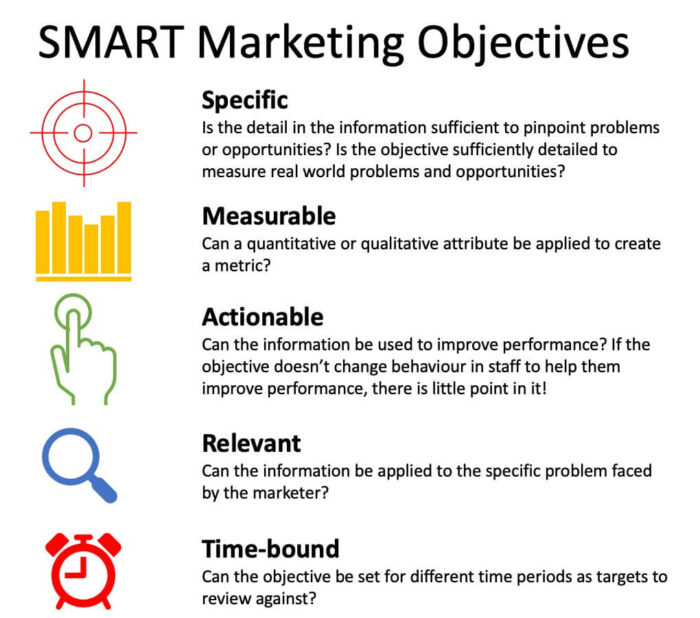
Keep your strategic objectives SMART, link your objectives to strategies and KPIs, and make sure all of your team know exactly what the target is.
Smart Insights have marketing tools and techniques to keep your team on track. Managers can utilize our advanced module forecast results and ROI for digital marketing activities, for Business Members, to set goals.
What is the difference between goals and objectives
I’ve found that goals and objectives are often defined and used differently within different companies or parts of a business and this can lead to problems when creating processes to track and improve marketing performance. This post explains the difference between marketing objectives and marketing goals and why it matters!
Examples of SMART marketing objectives
Here are some typical examples of SMART objectives. I’ve included one example across each stage of our RACE Growth System of Plan > Reach > Act > Convert > Engage. There are 2 examples for conversion objectives, as we know many businesses are setting new types of goals to help them navigate the difficult commercial landscape.
- Audit objective: Review all in-house whitepapers relating to digital transformation and identify top 3 priorities to update next quarter.
- Digital traffic objective. Achieve 10% more traffic from a key channel or country within two years.
- MQL objective: Increase demo bookings from email channel.
- Acquisition objective: Acquire 50,000 new online customers this financial year at an average cost per acquisition (CPA) of £30 with an average profitability of £5.
- Conversion objective: Increase the average order value of online sales to £42 per customer.
- Engagement objective: Increase active customers purchasing at least once a quarter to 300,000 in a market (a hurdle rate metric).
Apply the RACE Framework to focus your marketing objectives on your customers’ experiences
Naturally, you will want to set different objectives to help you encourage your customers to take action at different stages in their purchase journey.
If you are raising awareness, your objectives and metrics will center around brand positioning, such as brand searches, and paid media impressions. Whereas conversion-related objectives could include CRO, VQVC, or email nurturing.
That’s where our RACE Framework comes in. A fully worked marketing and sales funnel including recommended marketing activities, KPIs, and integrations to help you plan a streamlined, effective customer journey.
We recommend integrating all your SMART marketing objectives across the RACE Framework, which you can follow below.
Our RACE Growth System has been designed to help you quickly create and action a digital marketing plan using the RACE Framework to improve your results from marketing.
By structuring your objectives across your customers’ lifecycle stages, you can measure granular metrics and customer-centric data to inform your goal setting and tracking.
Examples of SMART Objectives across RACE
Below are three SMART objectives (Specific, Measurable, Achievable, Relevant, Time-bound) for each stage of the framework in an annual digital plan.
Plan (Strategy & Research) example objectives
- 1. Conduct a full digital audit of website, SEO, and paid media performance, delivering a report with actionable insights by Q1.
- 2. Develop a customer persona strategy based on first-party data and market research, ensuring at least three well-defined personas by end of Q1.
- 3. Set annual KPIs for digital channels, aligning with business goals to increase website traffic by 20% YoY and improve social media engagement by 15% by year-end.
Reach (Brand Awareness & Traffic Growth) example objectives
- 1. Increase organic search traffic by 25% through an SEO strategy focusing on high-intent keywords and technical optimizations by Q4.
- 2. Boost paid media efficiency, achieving a 20% lower cost-per-click (CPC) while maintaining conversion rates by Q3.
- 3. Grow social media reach by 30% YoY, leveraging influencer collaborations and platform-specific content by year-end.
Act (Lead Generation & Engagement) example objectives
- 1. Improve on-site engagement by increasing average session duration by 15% and reducing bounce rate by 10% through UX improvements and content optimization by Q3.
- 2. Generate 10,000 new leads through gated content, webinars, and lead magnets by Q4.
- 3. Increase email sign-ups by 20% via personalized pop-ups and optimized landing pages by mid-year.
Convert (Sales & Revenue Growth) example objectives
- 1. Improve conversion rate by 10% by testing and optimizing checkout processes, CTAs, and landing pages by Q4.
- 2. Increase eCommerce sales by 20% through retargeting campaigns, cart abandonment emails, and personalized offers by year-end.
- 3. Boost email marketing revenue by 15%, refining segmentation and automation workflows by Q3.
Engage (Loyalty & Advocacy) example objectives
- 1. Increase customer retention by 10%, implementing loyalty programs and personalized post-purchase communication by Q3.
- 2. Grow customer referral program participation by 25%, incentivizing user-generated content and advocacy by Q4.
- 3. Enhance customer support response time, ensuring 90% of inquiries are resolved within 24 hours across digital channels by mid-year
These objectives align with a structured digital marketing plan, ensuring growth across acquisition, conversion, and retention. Would you like a more tailored approach based on a specific industry or business type?
How can SMART objectives help set realistic goals?
When setting future digital marketing objectives, such as in a digital marketing plan, it’s useful to look hard at each measure and ask “can it be done?” and “will it help?”.
The SMART mnemonic helps as a test or filter that you can use to assess the quality of measures. The Smart Insights definition of SMART is:
-
- Specific – Can the detail in the information be sufficient to pinpoint problems or opportunities? Is the objective sufficiently detailed to measure real-world problems and opportunities?
- Measurable – Can a quantitative or qualitative attribute be applied to create a metric?
- Actionable – Can the information be used to improve performance? If the objective doesn’t change behavior in staff to help them improve performance, there is little point in it!
- Relevant – Can the information be applied to the specific problem faced by the marketer?
- Time-bound – Can objectives be set for different periods as targets to review against?
The Ten Measures Design Tests
You can add to your tests of choosing the right marketing objectives using these 10 measure design tests developed by performance management specialist Professor Andy Neely. For SMARTER metrics, ask these questions for your KPIs as you develop them.
-
- 1. The truth test. Are we measuring what we set out to measure?
- 2. The focus test. Are we only measuring what we set out to measure?
- 3. The relevancy test. Is it the right measure of the performance measure we want to track?
- 4. The consistency test. Will the data always be collected in the same way whoever measures it?
- 5. The access test. Is it easy to locate and capture the data needed to make the measurement?
- 6. The clarity test. Is any ambiguity possible in interpreting the results?
- 7. The so-what test. Can and will the data be acted upon, i.e. is it actionable?
- 8. The timeliness test. Can the data be accessed rapidly and frequently enough for action?
- 9. The cost test. Is the measure worth the cost of measurement?
- 10. The gaming test. Is the measure likely to encourage undesirable or inappropriate behaviors?
These tests show there are additional filters on top of SMART that are useful to choose the best measure. I particularly like the “So-what test, another way of explaining relevance and Gaming – a common issue with target setting that isn’t considered by SMART!
Alternative SMART objectives definitions
Finally, some have developed the SMARTER objectives definition that shows the need to re-examine the relevance of SMART objectives over time.
This definition certainly shows the many alternative digital marketing objectives definitions – you may want to compare your current approach against these!
| Letter | Most Common | Alternative |
|---|---|---|
| S | Specific | Significant, Stretching, Simple, Sustainable |
| M | Measurable | Motivational, Manageable, Meaningful |
| A | Attainable | Appropriate, Achievable, Agreed, Assignable, Actionable, Adjustable, Ambitious. |
| R | Relevant | Results-Based, Results-Oriented, Resourced, Realistic, Reasonable. |
| T | Time-Bound | Timed, Time-Framed, Time-Specific, Timetabled, Time-limited, Trackable, Tangible. |
| E | Evaluate | Ethical, Enjoyable, Engaging, Evidenced |
| R | Reevaluate | Reviewed, Rewarded, Revisit, Recordable, Rewarding, Reaching. |
Set and achieve your business SMART objectives
Now that we’ve defined what SMART objectives mean for you and your marketing strategy. What are your next steps, and how can you ensure you achieve your goals.
We’ve got a library of ready-to-go marketing strategy tools and templates, all integrated across the RACE Framework, to support you:
- Setting your marketing objectives
- Tweaking and improving your marketing activities in line with your goals
- Managing your team and accelerating results
- Applying data and customer insights to constantly review and adapt your strategies and tactics
Whether you want to improve your Google Analytics skills, train your team, or apply new data-driven templates for growth forecasting, we recommend using our RACE Growth System to springboard your marketing from strategy into action.
All our marketing solutions are integrated across RACE so you can confidently apply your findings to improve your marketing across one, some, or all of the stages of your customer lifecycle.
Through RACE, you can identify new opportunities at every stage of your marketing cycle and prioritize the key journeys that drive the results you need. Download your free RACE Growth System template to learn how you could grow your business with Smart Insights.

